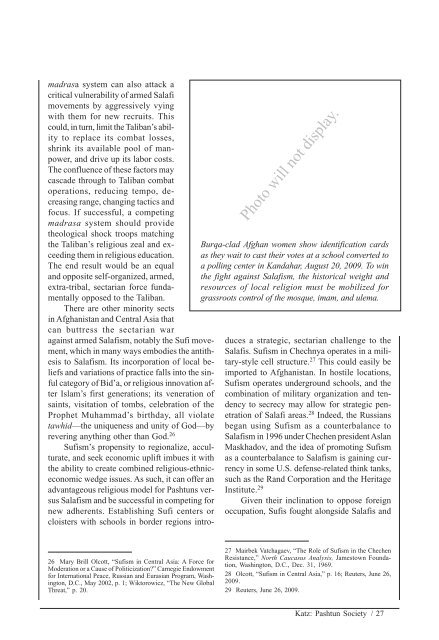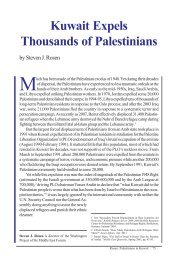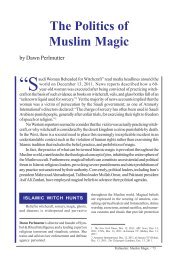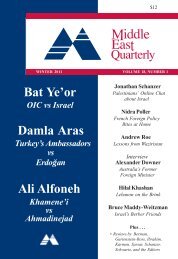parts until the local movement collapses—an approachthat was successfully employed inChechnya and Algeria where the Armed IslamicGroup’s methods were so violent as to be questionedby some Salafi clerics. 21While both counter-strategies are feasible,the “foreignness” approach is most accessibleand universal. Initially, Salafi sects must be denieda local foothold by the development anddeployment of wedge issues that separate themfrom traditional, local village society. These canrange across numerous sectarian, ethnic, andnational divides as the Pakistani military attemptedto wedge the Ahmadzai Wazir andMeshud Taliban factions apart in Waziristan. 22Ultimately, the theocratic case against Salafi Islamcan be made and formalized in religious rulings(fatwas) issued by respected Pashtun ulema,something that should not be too difficult giventhe Taliban’s low level of religious knowledge.Once the divide is drawn between Salafismand local, traditional Islam, the historical weightand resources of local religion must be mobilizedfor challenging Salafism for grassroots controlof the mosque, imam, and ulema. Imams canbe recruited to report on parishioners who challengetraditional doctrine.Parishioners canGrassroots seize the religious endowmentsof radicalizedpatriotism couldmosques or the mosquesfuel rejection themselves. Establishingan affiliated, ruralof foreignconcepts such Hanafi Islamic madrasa(school) system, providinga local center of grav-as Wahhabism.ity for community-basedsocial services, job training and placement,youth recruitment and education, all within preexistingqawm and manteqa structures providesanother avenue for challenging Salafism. As withradical Islamic schools, these madrasas shouldbe free of charge and driven by missionary zeal.As such, they should be able to attract vettedand trained ulema and clerics as well as thebrightest and most ambitious students sinceofficial recognition of their diplomas would providea safe and lucrative avenue to governmentemployment and social services. 23Such a system can provide a means for reinforcingand defending local religion’s positionwithin the village social network while drivingSalafism outside it. It employs the same methodused to install Salafism in the Pashtun areas ofPakistan’s Northwest Frontier Province andBaluchistan during the 1980s but to oppositeeffect. 24 For example, emphasizing the differencesbetween Pashtunwali and Salafi interpretationsof the Shari‘a can create internal contradictionsfor Salafi Pashtuns, forcing them tochoose between being good Pashtuns and goodSalafis. Likewise, the employment of local ulemaand mullahs provides them with a material incentiveto spread the message within villagesociety. At a minimum, it co-opts local religiousresources and prevents their co-optation by others.Affiliation among local madrasas aids informationflow and facilitates rapid response.Coupled with provincial associations for regionalulema and mullahs for additional education,specific services, and mutual defense, thesystem creates a religious critical mass competingdirectly with Salafi Islam—all without directgovernment presence.The outcome is a coherent distributionchannel for a competitive Pashtun Hanafi religiousmodel where the individual adherent canbe both a good Pashtun and a good Muslim asopposed to the Salafi model that rejects traditionalPashtun social structure. 25 A competing21 Quintan Wiktorowicz, “The New Global Threat:Transnational Salafis and Jihad,” <strong>Middle</strong> <strong>East</strong> Policy, Dec. 2001,pp. 25, 30.22 Mona Kanwal Sheikh, “Disaggregating the PakistaniTaliban,” Danish Institute for International Studies Brief,Copenhagen, Sept. 2009, p. 5.23 Olivier Roy, “Islamic Radicalism in Afghanistan and Pakistan,”U.N. High Commissioner for Refugees (UNHCR), Emergencyand Security Service, Jan. 2002, p. 11; S.J. Malik,“Dynamics among Traditional Religious Scholars and TheirInstitutions in Contemporary South Asia,” The Muslim World,July-Oct. 1997.24 Rashid, Taliban, p. 89.25 Ibid., p. 92.26 / MIDDLE EAST QUARTERLY SPRING 2011
Photo will not display.Burqa-clad Afghan women show identification cardsas they wait to cast their votes at a school converted toa polling center in Kandahar, August 20, 2009. To winthe fight against Salafism, the historical weight andresources of local religion must be mobilized forgrassroots control of the mosque, imam, and ulema.madrasa system can also attack acritical vulnerability of armed Salafimovements by aggressively vyingwith them for new recruits. Thiscould, in turn, limit the Taliban’s abilityto replace its combat losses,shrink its available pool of manpower,and drive up its labor costs.The confluence of these factors maycascade through to Taliban combatoperations, reducing tempo, decreasingrange, changing tactics andfocus. If successful, a competingmadrasa system should providetheological shock troops matchingthe Taliban’s religious zeal and exceedingthem in religious education.The end result would be an equaland opposite self-organized, armed,extra-tribal, sectarian force fundamentallyopposed to the Taliban.There are other minority sectsin Afghanistan and Central Asia thatcan buttress the sectarian waragainst armed Salafism, notably the Sufi movement,which in many ways embodies the antithesisto Salafism. Its incorporation of local beliefsand variations of practice falls into the sinfulcategory of Bid’a, or religious innovation afterIslam’s first generations; its veneration ofsaints, visitation of tombs, celebration of theProphet Muhammad’s birthday, all violatetawhid—the uniqueness and unity of God—byrevering anything other than God. 26Sufism’s propensity to regionalize, acculturate,and seek economic uplift imbues it withthe ability to create combined religious-ethniceconomicwedge issues. As such, it can offer anadvantageous religious model for Pashtuns versusSalafism and be successful in competing fornew adherents. Establishing Sufi centers orcloisters with schools in border regions introducesa strategic, sectarian challenge to theSalafis. Sufism in Chechnya operates in a military-stylecell structure. 27 This could easily beimported to Afghanistan. In hostile locations,Sufism operates underground schools, and thecombination of military organization and tendencyto secrecy may allow for strategic penetrationof Salafi areas. 28 Indeed, the Russiansbegan using Sufism as a counterbalance toSalafism in 1996 under Chechen president AslanMaskhadov, and the idea of promoting Sufismas a counterbalance to Salafism is gaining currencyin some U.S. defense-related think tanks,such as the Rand Corporation and the HeritageInstitute. 29Given their inclination to oppose foreignoccupation, Sufis fought alongside Salafis and26 Mary Brill Olcott, “Sufism in Central Asia: A Force forModeration or a Cause of Politicization?” Carnegie Endowmentfor International Peace, Russian and Eurasian Program, Washington,D.C., May 2002, p. 1; Wiktorowicz, “The New GlobalThreat,” p. 20.27 Mairbek Vatchagaev, “The Role of Sufism in the ChechenResistance,” North Caucasus Analysis, Jamestown Foundation,Washington, D.C., Dec. 31, 1969.28 Olcott, “Sufism in Central Asia,” p. 16; Reuters, June 26,2009.29 Reuters, June 26, 2009.<strong>Katz</strong>: Pashtun Society / 27
- Page 1 and 2: $12SPRING 2011 VOLUME 18, NUMBER 2T
- Page 3 and 4: SPRING 2011 VOLUME 18, NUMBER 2THE
- Page 5 and 6: The Afghanistan ConflictMission Cre
- Page 7 and 8: countries.” 5 Out of twentyfiveai
- Page 9 and 10: Photo will not display.Rather than
- Page 11 and 12: Tajik, Uzbek, and Hazara, known as
- Page 13 and 14: Taliban and the Islamist Haqqaninet
- Page 15 and 16: detrimental to any campaign. The ma
- Page 17 and 18: 47 Noah Feldman, What We Owe Iraq:
- Page 19 and 20: The Afghanistan ConflictReforming t
- Page 21 and 22: operations gave way to compellingth
- Page 23 and 24: whether religious, economic, social
- Page 25 and 26: Decentralization also imposesan obl
- Page 27: ernmental goods and services to the
- Page 31 and 32: wifery-based prenatal and childbirt
- Page 33 and 34: The Afghanistan ConflictIndia’s C
- Page 35 and 36: allowing reciprocal concessionsto I
- Page 37 and 38: more autonomous foreign policy. The
- Page 39 and 40: 27 The Hindustan Times (New Delhi),
- Page 41 and 42: lateral political realignment. 35 F
- Page 43 and 44: Turkey’s Christiansunder Siegeby
- Page 45 and 46: new system of church-state relation
- Page 47 and 48: tion in Turkey by declaring his opp
- Page 49 and 50: efore firing his pistol. 38 BishopP
- Page 51 and 52: as an instrument of deal-makingwith
- Page 53 and 54: Turkish state minister Mehmet Aydø
- Page 55 and 56: Abbas vs. Obamaby Steven J. RosenHa
- Page 57 and 58: international community in supporto
- Page 59 and 60: Since the start of the Obama admini
- Page 61 and 62: Damascus on Trialby David SchenkerI
- Page 63 and 64: Hersh, if Washington had agreed to
- Page 65 and 66: 21 Reports of the judgment appeared
- Page 67 and 68: UTA airlines after Libya was found
- Page 69 and 70: NGOs vs. Israelby Ben-Dror YeminiOn
- Page 71 and 72: that news of an agreement leaks out
- Page 73 and 74: and a string of European states, in
- Page 75 and 76: DATELINEEgypt’s AntiquitiesCaught
- Page 77 and 78: DATELINEday. Antiquities represent
- Page 79 and 80:
State and military industriesdomina
- Page 81 and 82:
DATELINEAll Ahmadinejad’s Menby A
- Page 83 and 84:
DATELINESadegh Zibakalam, 21 who re
- Page 85 and 86:
The Science and TechnologyRing. Fol
- Page 87 and 88:
DATELINELebanon’s Islamist Strong
- Page 89 and 90:
Outward manifestations ofmodernity
- Page 91 and 92:
minister’s militia, to serveas a
- Page 93 and 94:
REVIEWSBrief ReviewsThe Arab Public
- Page 95 and 96:
REVIEWSception. Their arguments are
- Page 97 and 98:
REVIEWSMiddle East that is experien










